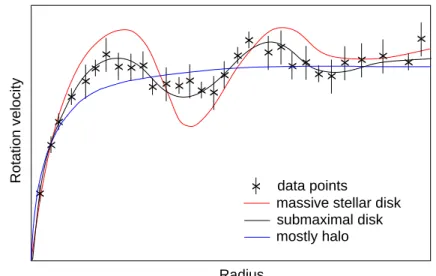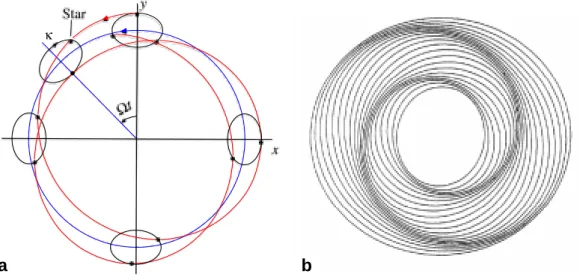Luminous and Dark Matter in
Spiral Galaxies: A New Test
C . HAPTER II
In almost all galaxy formation scenarios non-baryonic dark matter plays an important
role. Today's numerical simulationsof cosmological structure evolution reproduce fairly
well the observed distribution of galaxy properties in the universe (e.g., Kaumann et
al. 1999) and attemptsto modelthe formationof single galaxies have been madeas well
(Steinmetz & Muller 1995). In these simulations the baryonic matter cools and settles
in the centers of dark halos where it forms stars. The distribution of stars and gas ina
galaxy depends strongly on the local star formation and merging history. At the same
timethat thestarsareforming thehalosevolve and mergeaswell.
2.1. Maximal disks or not?
Thenalrelativedistribution ofluminousanddark matterinthecenters of theresulting
galaxies is under debate because the mass distribution of the dark matter component is
diÆcultto assess directly. Measuring luminous and dark matter massproles separately
requires innovative strategies because the halo is poorly constrained and equally good
ts to measured rotation curves can be achieved for a wide range of visiblemass com-
ponents (e.g., Broeils & Courteau 1997). In order to dene a unique solutionto this so
called\disk-halodegeneracy",the\maximaldisk"solutionwasintroduced. Itassumesthe
highestpossiblemass-to-lightratio(M/L)forthestellardisk(van Albadaetal.1985; van
Albada &Sancisi1986). A practical denitionisgiven bySackett (1997) who attributes
theterm\maximal" to astellar diskifit accounts for85% 10%of thetotal rotational
supportofthe galaxyat R=2.2R
exp
. Thisapproachhasprovento bevery successfulin
matchingobservedHIandHrotationcurves(vanAlbadaetal.1985;Kent1986;Broeils
&Courteau1997;Salucci&Persic1999,Palunas&Williams2000)andalsosatisessome
dynamicalconstraints,suchasthecriteriaofformingm=2spirals(Athanassoula,Bosma
& Papaioannou 1987) as well as observational constraints on the structure of the Milky
Way(Sackett1997). However, modernnumericalN-bodysimulationsndsignicant cen-
traldark matter density cusps(Fukushige& Makino 1997; Moore etal. 1999a). Even if
the predictionof these strong density cuspsmay not be entirely correct, the simulations
ndthatthedarkmatterisof comparableimportanceintheinnerpartsof galaxies(Blu-
menthal et al. 1986; Moore 1994; Navarro, Frenk&White 1996, 1997)and itthus hasa
considerableinuenceonthekinematics. Inthiscaseastellardiskofagalaxywouldturn
outto be\sub-maximal".
Itisimportanttodeterminetherelativeproportionofdarkandluminousmatteringalax-
ies for a better understanding of the importance of the baryonic mass in the universe.
Thisproportionalso bearsinformationon thedynamicsandstructureofthedark matter
itself. Spiral galaxies are well suited to study dark matter distributions because their
distinctly orderedkinematics provide an excellent tracer of thegravitational potentialin
the diskplane. Since bars ingalaxies are very prominent features with distinctdynamic
characteristics,they areespeciallywellsuitedtoevaluatetheamountof luminousmatter.
Sophisticated studies of barred galaxies indicate that their stellar disks alone dominate
the kinematics of the inner regions { the stellar contribution is maximal (Debattista &
Sellwood1998, 2000;Weineretal.2001a). However,studiesofourownMilkyWay,found
alsotobeabarredspiral,stilldonotgiveaclearanswerastowhetherthediskismaximal
(Sackett1997;Englmaier&Gerhard1999)ornot(Kujiken1995;Dehnen&Binney1998).
Bottema's analysis of the stellar velocity dispersion in various galactic disks led to the
conclusion that disks cannot comprise most of the mass inside the radial range of a few
exponential scale lengths (Bottema 1997). Aside from the dynamical analysis of single
systems,otherattemptsto tacklethisproblemhavebeenundertaken. Malleretal.(2000)
usedthegeometryofgravitationallenssystemstoprobethepotentialofalensinggalaxy.
Theyconcluded thata maximumdisksolutionishighly unlikely. Courteau &Rix (1999)
appliedstatisticalmethodsto learnaboutthemassdistributioningalaxies. Intheiranal-
ysis they foundno dependence of themaximum rotation velocity on agalaxy's disk size.
Theconictingndingsofdierentstudiesleavethequestionof therelativeproportionof
dark and luminousmatterin galaxiesstillopen.
2.2. The concept
Inthisthesisthefactisexploited,that thestellarmassindiskgalaxiesisoftenorganized
in spiralarms, thus in kinematicallycold non-axisymmetric structures. In the canonical
CDM cosmology the dark matter is collisionlessand dominatedbyrandommotions. Al-
thoughtheintroductionofweaklyself-interactingdarkmatterwasproposedtoavoidcur-
rent shortcomingsoftheCDMmodel(Spergel&Steinhardt2000)itseemstoraiseother,
comparably severe problems (Yoshida et al. 2000; Ostriker 2000; Miralda-Escude 2002).
Hence it seems reasonable to assume that CDM is not substantially self-interacting, but
dynamicallyhot and therefore not susceptibleto non-axisymmetricspiral orother small
scalestructure.
In light of this, the key to measuring the baryonic and dark matter mass fractionsis to
make useof the non-axisymmetricstructurethatcan be observed inthestellar lightdis-
tribution. Usingdeviationsfrom axisymmetryofstellardisks,severaleortshave already
beenmade toconstrainthedarkmatter contentof non-barredspiralgalaxies(e.g., Visser
1980;Quillen1999,andreferencestherein). Someofthemostsignicantconclusionscame
fromstudiesofmassivebars,whicharethestrongestnon-axisymmetricstructures indisk
galaxies. Spiral arms comprisea less prominent, butstill signicant mass concentration.
Already very early theoretical calculations of gas shockingin the gravitational potential
ofaspiralgalaxy (e.g.,Roberts1969)cameto theconclusionthat\velocitywiggles"with
x x x
x x x x
x x x
x x
x x x
x x x
x x
x x x x
x
x x x x x
x
data points
massive stellar disk submaximal disk mostly halo
Rotation velocity
Radius
Figure 2.1 Idea of the project. The measured gas velocity eld (ctional data points) should be
matchedbyamodelledgasvelocityeldfromhydrodynamicalsimulation(continuouslines). Themass
fractionof the non-axisymmetric stellar mass contributiondetermines the amplitudeof the \velocity
wiggles" in the simulations and is adjusted to match the observations. In the depicted scenario a
submaximaldisk(black line)yieldsthebestttothedata.
anamplitudeof10to 30kms 1
couldbeexpectedwhilecrossingmassivespiralarms. For
ionizedgas, measurementsof thevelocity to thisprecisioncan beachieved with common
longslitspectrographs. The imprint of thespiralpattern inthevelocityeld of observed
galaxiesisindeednotverystrong,asapparentinthe2DvelocityeldsofM100(Canzian
&Allen1997),oflowsurfacebrightnessgalaxies(Quillen&Pickering1997)orofasample
of spiral galaxies (Sakamoto et al. 1999). There are only a few spiralgalaxies without
bars that show stronger wiggles in the velocity eld that are associated with the arms,
e.g.,M81 (Visser1980; Adler&Westpfahl 1996) andM51 (Aaltoetal. 1999).
Inorderto stillachievethegoalof measuringmass-to-lightratiositis neededto compare
theexpectedly weak featuresinthemeasuredvelocityeld to detailedkinematicmodels.
TheuseofnewhighresolutionK-bandphotometrytomapthestellarcomponentandthe
applicationofamodernhydro-codetosimulategalacticgasowsestablishesasoundbasis
forthemodelsto showenoughdetailsandenablethemeasurementofmass-to-lightratios.
Ifthearmsareanegligiblemassconcentration relative tothedark matterdistributionin
the galaxy, these wiggles should appearonly very barely inthe velocity eld. The main
aim of this projectis to ndout what fraction of therotation speed comesfrom a mass
component withspiralarms. In order to do thisthestrength of thewigglesina galaxy's
observedvelocityeldhavetobecomparedtoamodelofthegasvelocityeldarisingina
potentialwhose disk-halofraction is known. As inputfor thegas dynamicalsimulations,
it is necessary to derive the stellar potential of the galaxy from color-corrected K-band
photometry, whilethe dark matter component is modelled as an isothermal sphere with
a core. Simulationsare performed fora variety of potential combinationsand valuesfor
the pattern speed of the spiral structure. The results from these simulations are then
comparedto the observed kinematics.
2.3. The spiral structure of galaxies
Forthepresentanalysisthekeyelementisthenon-axisymmetricspiralstructureobserved
inthestellarand gaseouscomponentsof manydiskgalaxiesand thewayitisdepictedin
their velocity elds. Understanding the basics of spiral morphology is essential in order
to apply theappropriate modellingprocess. In thisSection I briey review the relevant
concepts. Fora thoroughintroductionintheeldsee Athanassoula(1984).
The spiral structure is closely related with the global dynamics of disk galaxies. Due
to the dierential rotation in the disk, a once established spiral would wind up into a
very tight curl within a few dynamical time scales. Thus, the observed spirals cannot
comprise ofan aligned,xed populationof stars, butrather involve all starsmaintaining
a \kinematic density wave" in the disk. The spiral arms appear in domains, where the
stars are packed more densely and move slower on their orbits. The density wave also
induces shocks in the interstellar medium, causing star formation along the spiral arms.
Under these circumstances,the newlyformed starsmake thespiralarmsto appear bluer
than the inter-arm regions. However, grand design spirals are not the product of a self
propagatingstar formationwave as suggested byGerola & Seiden(1978). Thisbecomes
apparent from NIR imaging, mainlytracing the old stellarpopulations, where the spiral
armsare stillclearlyvisible.
a
κ
b
Figure 2.2 The principles of spiralstructure. a) In aninertial referenceframe (x,y) a star'sorbital
motioncanbeimaginedasbeingacombinationofaretrogradeorbitaboutanepicyclewithfrequency
andtheprogradeorbitalmotion(blueline). Inthisreferenceframethestar'spathformsanon-closing
rosette pattern(red curve). b)Nestedovalorbitswitharelative phaseshift,as seenin anon-inertial
referenceframerotatingtheglobalangularpatternspeed
p
,canresultinagranddesignspiraldensity
wave. Adapted fromCarroll&Ostlie(1996)
The principlesof aspiraldensitywave weredeveloped by B.Lindbladand J.Oortinthe
mid of last century, namely the epicycle theory. In an inertial reference frame a star's
orbitalmotioncan be describedbyits circularmotionoffrequencyaroundthegalactic
center, superposedwith an oscillation of frequency around the guiding center. In this
\epicyclic approximation", stellar orbits generally follow a non-closing rosette trajectory
inthegalactic disk(see Figure 2.2a).
However, fora varietyof applicationsitisusefulto introducesome non-inertialreference
frame, rotating with an orbital frequency
p
. The advantage of thisreference frame is,
that
p
can be chosen suchthat theorbit ofthe star isclosed. For nearlycircular orbits
therequirement fora closedorbitisfullled, when(
p
)= isrational:
p
(R )=(R ) n
m
(R ): n and mare integers: (2.1)
While for most values for n and m n
m
varies rapidly with radius, for n = 1 and
m =2 it is relatively constant across much of thegalaxy. In this scenario, the orbits of
thestars asseen from therotating reference frameare ellipses. If these orbitsare nested
andaligned inacollective manneracrossthedisk, dierentwave patterns can be created
(see Figure 2.2b). As viewed from an inertial frame the pattern retains its morphology,
butrotateswith theangularfrequency
p
. Thus,
p
iscalled thepatternspeed.
In the 1960s Lin and Shu (1964, 1966) developed the more elaborate quasi-stationary,
linear density wave theory (for a review, see Bertin & Lin 1996). In this approach the
spiral density wave is described as a the most unstable oscillation mode of the galactic
disk. The amplitudeof thespiralpatternevolves byinteractionsofthese modeswiththe
dissipativecharacter oftheinterstellarmedium. The stellarspiralpatternextends inthe
radial range between the innerLindblad resonance (ILR) and the corotation if they are
stationary. Iftheyare growingtheycan extendeven outto theouterLindbladresonance
(OLR)(e.g., Linetal. 1969; Toomre 1981; Bertinet al.1989a,b). The ILRand OLR are
resonancesbetweentheepicyclicprecessionfrequencies=2andthepatternspeed
p .
Due to the stability of the spiral structure resonances play a crucial role also for the
morphologicalappearance of thegalaxy. Forexampleat thecorotationradius,wherethe
patternspeed
p
isequaltotheorbitalfrequency,theresponseofthegasisnotperiodic
sincethe gas rotates along withthe spiralperturbations and thusthe non-axisymmetric
forcingvanishes. In light of this, itis expected that at the corotation radiusstar forma-
tion cannot get excited by the density wave and should not be observed in a quiescent
galaxy. The locationof thisresonance shouldbecome visibleasa ring of largelyreduced
star formation(Shuetal. 1973).
However, in real galaxies the situation seems to be more complicated. In normal spiral
galaxies with relatively open spirals, orbits belonging to the main orbital families devi-
atesignicantlyfromcircularorbits,withtheconsequencethatnon-lineareectsbecome
important. The importanceof non-linear eectsin realisticmodelsof spiralgalaxies was
studied by Contopoulos & Grosbl (1986, 1988) and Patsis et al. (1991). It was found
that at least for late type spiral galaxies, non-linear eects cause the response density
to grow out of phase with the underlying potential already inside corotation and con-
sequently the strong part of the spiral terminates at the 4/1 resonance, that is located
roughlyhalfwaytocorotation. If,however, thepotentialperturbationisweak, non-linear
eects playa minor role. It isvery diÆcult to settle these issueson an observational ba-
sis,sincethelocationsoftheresonancesaregenerallynotverywellknownforrealgalaxies.
Besides retaining the morphological shape of the spiral pattern, the question must be
assessed on how the spiralmaintains the amplitude of the densitywave. Like any other
wave travellingthrough a medium, also thespiraldensity wave needs to get regenerated
continuously,or at least at certain times,to prevent it from dispersing and fading away.
One internalmechanism has been proposed forgalaxies that is referred to asswing am-
plication(Toomre 1981). If thepatternspeed
p
ishighenoughthat noILR ispresent,
density waves can travel through the center of the disk, changing from a trailing to a
leading spiral. Due to thedierentialrotation inthe disk, theleading wave,propagating
outwards towards corotationgets converted into a trailingwave. During thisprocess the
wave cangetampliedbyafactor 10ormore. Iftheswingamplicationisnotembedded
into afeedbackcycle,themechanismwould notprovidea quasi-stationaryspiralpattern.
Anotherinternalmechanism todrive aspiralpattern isa centralbar orovalasymmetry.
Indeed, it has been found that already in simple modelscentral bars can induce strong
spiralfeaturesinthedisk(Sanders&Huntley1976). Importantforthebardrivingmech-
anism is a dissipative interstellar medium. Modern analyses ndthat theinduced spiral
structure depends on the rotation speed of the bar. Spirals associated with the outer
Lindblad resonance, i.e. forfast bars,are tightlywound, whilethose associated withthe
innerLindbladresonancesfor slow barsarerelativelyopen(Yuan & Kuo1997).
Finally, tidalinteractiondueto a companion galaxy's ybymay enhance the spiralden-
sitywave (Toomre 1974). Duringtheybyangularmomentum isexchangedbetweenthe
companion and the wave. Asobserved intheprominentexamples of M51 and M81,the
spiralpattern,drivenbyexternaltidalinteraction, mightresult inveryregular grandde-
sign structure. The tidalforcingdepends stronglyon theorbitalparameters ofthe yby.
It matters, for example, if the companion orbits prograde or retrograde (Athanassoula
1978). Furthermore, the companion must pass fairly fast and closeto have a noticeable
eect on the spiral's disk morphology (Howard et al. 1993). To assure a tidally driven
quasi-stationaryspiralpattern,thecompanionmustorbitverycloselyaround thegalaxy.
However, thisscenario would also onlywork fora limited time because on a closeby, pe-
riodicorbitthecompanion ispredestined to mergewiththe spiralgalaxy.
Thereareeven more scenariosthathave beenproposedto causeormaintain spiralstruc-
ture. Nevertheless, the spiralstructure of a real galaxy inthe universe is the product of
several, simultaneously acting physical mechanisms. For selected objects one particular
process mightplaya dominant role. These galaxies maythenbe consideredastest cases
for that specic theory. For the present project, the primarily important criterion is a
strongspiralpattern. Itsoriginordrivingprocess is adierent issue.

